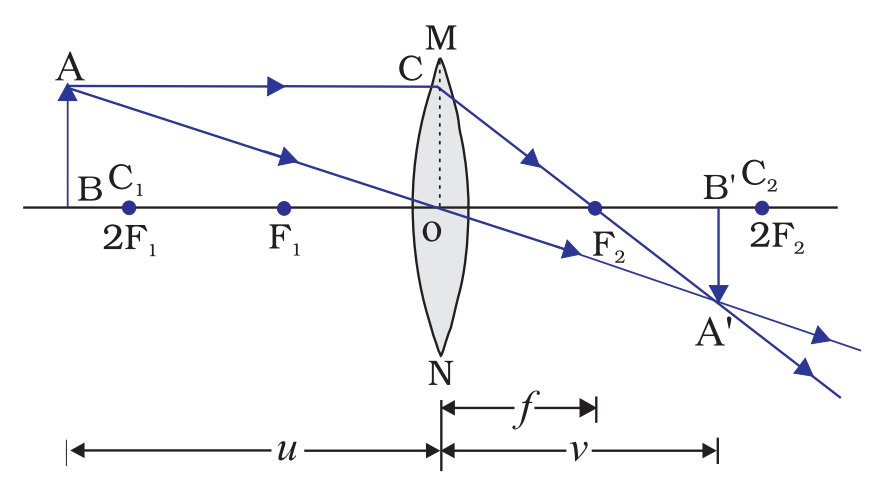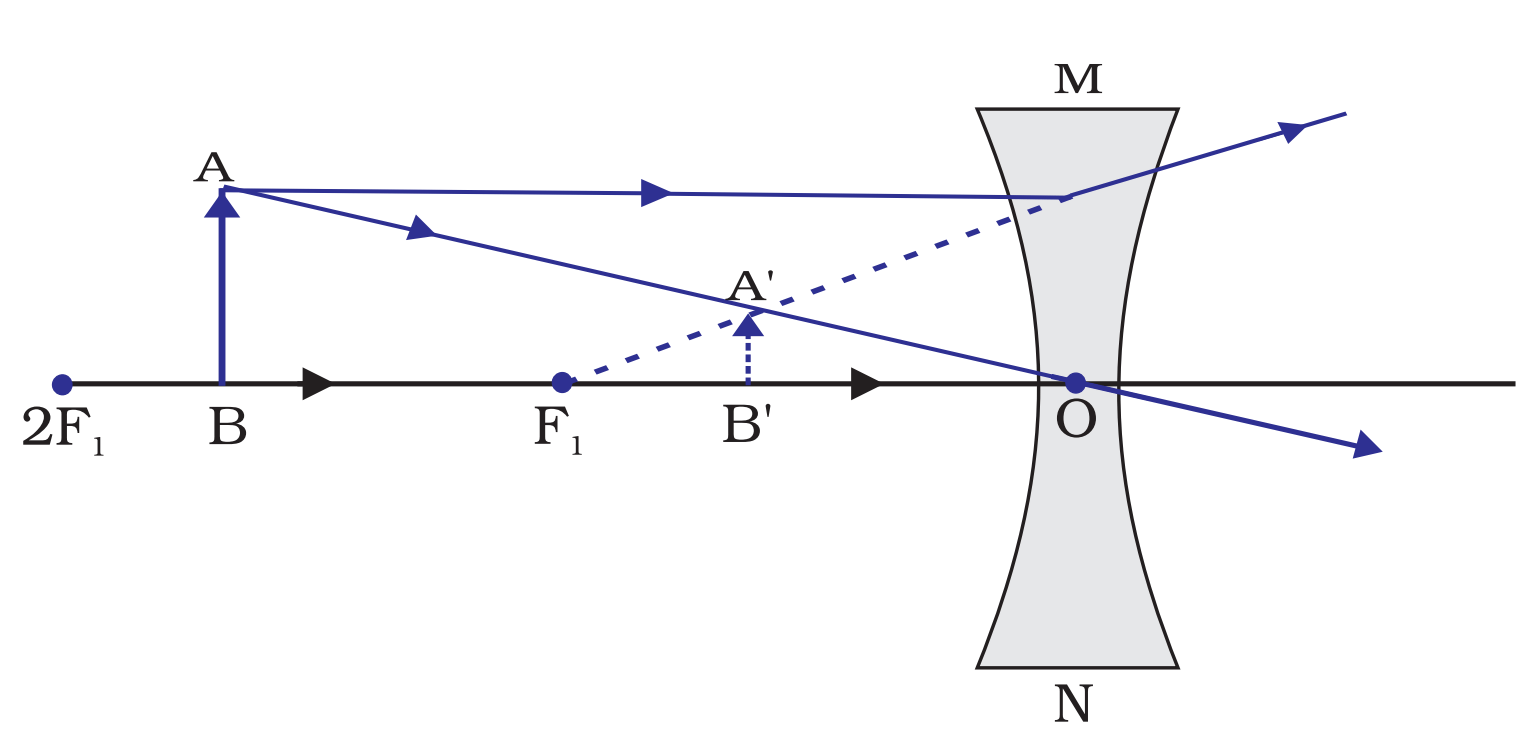| Class | 10th |
| Subject | Science (NCERT) |
| Category | Important Questions |
Light : Reflection and Refraction Class 10 Science Chapter 9 Important Question Answer
This Table is Most important for this chapter. Must revise this.
1. Nature, position and relative size of the image formed by a convex lens for various positions of the object

2. Image formation by a concave mirror for different positions of the object

Q1. Using a ray diagram, explain the position, relative size and nature of image of an object placed between the F1 and 2F1 of a convex lens.
Ans –

Here AB is the object. A’B’ is the Image of the object.
Position of object – Between F1 and 2F1
Position of the image – Beyond 2F2
Relative size of the image – Enlarged
Nature of the image – Real and inverted
Q2. Using a ray diagram, explain the position, relative size and nature of image of an object placed beyond 2F1 of a convex lens.
Ans –

Here AB is the object. A’B’ is the Image of the object.
Position of object – Beyond 2F1
Position of the image – Between F2 and 2F2
Relative size of the image – Diminished
Nature of the image – Real and inverted
Q3. Using ray diagram, explain position, size and nature of image of an object placed beyond centre of curvature C of a concave mirror.
Ans –

Here AB is the object. A’B’ is the Image of the object.
Position of object – Beyond Centre of Curvature C
Position of the image – Between Focus F and Centre of Curvature C
Relative size of the image – Diminished
Nature of the image of an object – Real and Inverted
Q4. Using ray diagram, explain position, size and nature of image of an object placed between focus F and centre of curvature C of a concave mirror.
Ans –

Here AB is the object. A’B’ is the Image of the object.
Position of object – Between Centre of curvature C and Focus F
Position of the image – Beyond Centre of curvature C
Relative size of the image – Enlarged
Nature of the image of an object – Real and Inverted
Q5. What is power of a Lens ? Define one Dioptre (1D) power of a lens. Most Important
Ans – The degree of convergence or divergence of light rays achieved by a lens in expressed in terms of its power. The power of a lens is defined as the reciprocal of its focal length.
P = 1/f
Dioptre is the SI unit of power of a lens. 1 Diopte can be defined as the power of a lens of focal length 1 metre. Dioptre is denoted by D.
Q6. Why do we prefer a convex mirror as a rear view mirror in vehicles?
Ans – Convex mirrors are used as rear-view (wing) mirrors in vehicles because these mirrors enables the driver to see the traffic behind him/her to facilitate the safe driving. Convex mirror always give erect and diminished image and give wider view as they are curved outwards.
Q7. An object is placed at the centre of curvature (c) of a concave mirror. Draw the ray diagram to depict the position, size and the nature of image formed. Most Important
Ans –

Here AB is the object. A’B’ is the Image of the object.
Position of object – At Centre of curvature C
Position of the image – At Centre of curvature C
Relative size of the image – same size
Nature of the image of an object – Real and Inverted
Q8. An object is placed at a position in between the main focus (F1) and the optical centre (O) of a convex lens. Draw a ray diagram showing the position, size and nature of the image formed. Most Important
Ans –

Here AB is the object. A’B’ is the Image of the object.
Position of object – Between focus F1 and Optical Centre O
Position of the image – On the same side of the lens as the object
Relative size of the image – Enlarged
Nature of the image – Virtual and Erect
Q9. Draw ray diagram and write nature of image formed if an object is placed at:
a) Between F1 and 2F1 of a concave lens.
b) Between F1 and 2F1 of a convex lens.
Ans –
(a) If the object is placed at F1 and 2F1 of a concave lens then nature of image will be virtual and erect. Here AB is the object. A’B’ is the Image of the object.

(b) If the object is placed at F1 and 2F1 of a convex lens then nature of image will be Real and inverted. Here AB is the object. A’B’ is the Image of the object.

Q10. Find the focal length of a lens of power -2.0 D. What type of lens is this? Most Important
Ans –
Power of lens P = 1/f
-2.0 = 1/f
f = 1/(-2) = -0.5 m
Concave lens has negative focal length. Therefore, given lens is concave.
Q11. Find the focal length of a lens of power +2.0 D. What type of lens in this ? Most Important
Ans – Power of lens P = 1/f
2.0 = 1/f
f = 1/(2) = 0.5 m
Convex lens has positive focal length. Therefore, given lens is convex.
Q12. Light enters from air to glass having refractive index 1.50. What is the speed of light in glass? The speed of light in vacuum is 3 × 108 ms-1.
Ans –
Let the speed of light in the glass be x m s–1.
Using,
Refractive index of transparent medium = Speed of light in vacuum / speed of light in medium
1.50 =
x =
x = 2 × 108 ms–1
Q13. An object 5.0 cm in length is placed at a distance of 20 cm in front of a convex mirror of radius of curvature 30 cm. Find the position of the image, its nature and size.
Ans –
Given object size, ho = +5 cm
Object distance, u = – 20 cm
Radius of curvature, R = 30 cm
Focal length, f = R/2 = 30/2 = 15 cm
Using mirror formula,
v = 60/7 = 8.6 cm
Magnification of mirror, m = =
hi = = 2.15 cm
Therefore, a virtual, erect image of height 2.15 cm is formed behind the mirror at a distance of 8.6 cm from the mirror.
Q14. A concave lens has focal length of 15 cm. At what distance should the object from the lens be placed so that it forms an image at 10 cm from the lens? Also, find the magnification produced by the lens.
Ans –
Given, focal length f = – 15 cm, Image distance, v = -10 cm, Object distance, u = ?
Using lens formula,
u = -30 cm
Therefore, object is placed 30 cm in front of the lens.

Magnification of lens, m = height of image /height of object = v/u
m = -10/-30 = 1/3
Q15. Find the focal length of a convex mirror whose radius of curvature is 32 cm. Most Important
Ans – Given R = 32 cm
Using, R = 2f
where R is radius of curvature and f is focal length.
32 = 2f
f = 16 cm
Q16. lf an object is placed on the infinity of a concave lens, then draw a ray diagram and explain the position size and nature of its image.
Ans –

Here AB is the object. A’B’ is the Image of the object.
Position of object – At infinity
Position of the image – At focus F1
Relative size of the image – Highly diminished and point sized
Nature of the image – Virtual and Erect
Q17. Write the laws of reflection of light.
Ans – Laws of Reflection :
(i) The angle of incidence is always equal to the angle of reflection, and
(ii) The incident ray, the normal to the mirror at the point of incidence and the reflected ray , all lie in the same plane.
Q18. Write the laws of refraction of of light. Most Important
Ans – Law of Refraction of light :
(i) The incident ray, the refracted ray and the normal to the interface of two transparent media at the point of incidence, all lie in the same plane.
(ii) The ratio of sine of angle of incidence to the sine of angle of refraction is a constant, for the light of a given colour and for the given pair of media. This law is also known as Snell’s law of refraction. If i is the angle of incidence and r is the angle of refraction, then,
, 0<i<90°
Q19. State the types of mirror used for:
(i) headlights in car
(ii) rear view mirror in any vehicle
(iii) solar furnace
Give reason to justify your answer in each case.
Ans – (i) Concave mirror is used in vehicles headlights to get powerful parallel beams of light.
(ii) Convex mirrors are used as rear-view (wing) mirrors in vehicles because these mirrors enables the driver to see the traffic behind him/her to facilitate the safe driving. Convex mirror always give erect and diminished image and give wider view as they are curved outwards.
(iii) Large concave mirrors are used to concentrate sunlight to produce heat in solar furnaces.
Q20. Write the lens formula.
Ans –
Where, u is object distance, v is image distance and f is focal length .
Q21. Write the mirror formula.
Ans –
Where v is image distance, u is object distance and f is focal length.
| Class 10 Science NCERT Solution | Click Here |
| Class 10 Model Papers [Latest] | Download Papers |
| Class 10 Old Question Papers | Download Papers |